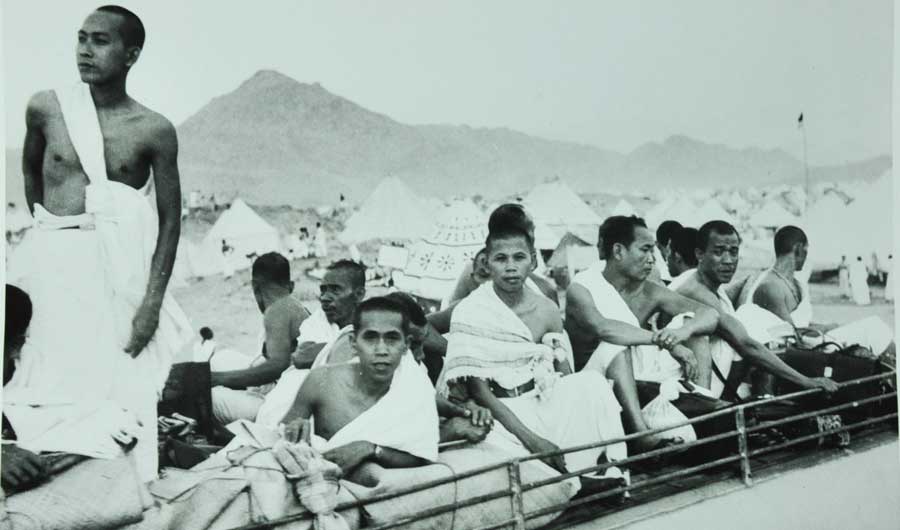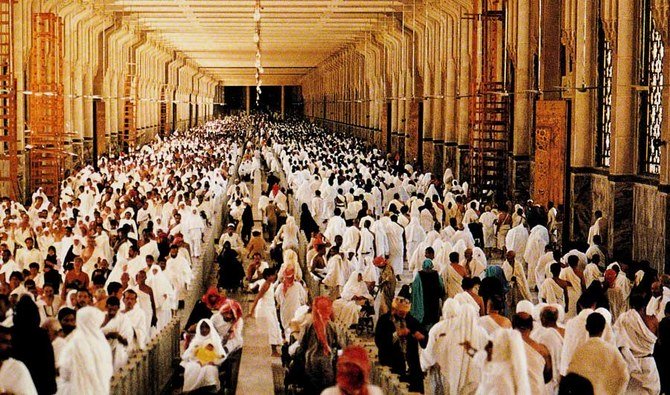LONDON: When the Saudi Ministry of Hajj and Umrah announced on June 22 that this year’s Hajj would be limited to a small number of pilgrims already resident in the country, the news, while disappointing for hundreds of thousands of Muslims worldwide, came as no real surprise.
From the very beginning of the global coronavirus outbreak, Saudi Arabia had acted swiftly and decisively to limit the impact of the disease, restricting air travel, imposing curfews and testing and quarantining thousands of people.
The authorities had not forgotten the harsh lessons learnt following the outbreak of Middle East respiratory syndrome (MERS) in 2012.
Linked to camels, MERS had started in the Kingdom and spread to 27 countries, claiming over 850 lives. But as bad as MERS was, its impact would soon be overshadowed by COVID-19.
By Friday, there had been more than 16 million recorded coronavirus cases worldwide, and over 645,000 lives had been lost.
Since recording its first case in early March — a Saudi who had traveled home from Iran — the Kingdom has seen 264,973 cases and 2,703 deaths.
Although a shocking toll, it is nevertheless mitigated by the actions taken by the state, as evidenced by statistics compiled by the Johns Hopkins University Coronavirus Resource Center.
Among those who have contracted the disease, Saudi Arabia has experienced a case fatality rate of only 1 percent, far better than many countries, including the UK (15.3 percent), Italy (14.3 percent) and France (14.1 percent).
The Kingdom has also suffered fewer deaths per 100,000 of population than many countries — 7.49 compared with 68 and 43 deaths per 100,000 people in the UK and the US respectively, for example.
As early as Feb. 27, before a single case had been discovered in Saudi Arabia, the Kingdom suspended visas for Umrah, the “lesser” pilgrimage that can be carried out at any time of year. In 2019, this attracted 19 million pilgrims, 7.5 million of them from outside the country.
Although it delayed a final decision over Hajj for as long as possible, at the beginning of April Hajj Minister Dr. Mohammed Salih Bentin advised Muslims worldwide to delay booking their trips.
“We’ve asked the world not to rush with regards to Hajj groups until the path of the epidemic becomes clear, keeping in mind the safety of pilgrims and public health as a priority,” he said.

In 2019, Hajj attracted 2.5 million pilgrims to Makkah, 1.85 million of them from overseas. By June 22, said the Ministry of Hajj and Umrah, it was clear that given “the risks of the disease and infections spreading in crowded gatherings” allowing 2 million pilgrims to descend on Makkah would invite disaster.
The decision was made to limit the number of pilgrims — selected from “various nationalities who already reside in Saudi Arabia” — to a token 1,000, a decision immediately welcomed by the World Health Organization (WHO).
“We understand that it wasn’t an easy decision to make, and we also understand it’s a major disappointment for many Muslims who are looking forward to making their pilgrimage this year,” said WHO Director-General Dr. Tedros Adhanom Ghebreyesus.
This, he added, was “another example of the hard choices that all countries must make to put health first.”
Although this is the first time Hajj has had to be restricted since the foundation of Saudi Arabia in 1932 brought law and order to the Arabian Peninsula, it is far from being the first time in its history that the annual pilgrimage has been disrupted.
 At the beginning of April, the King Abdul Aziz Foundation for Research and Archives (Darah) issued a statement highlighting 40 occasions on which Hajj had been either canceled or the number of pilgrims had been severely restricted, due to reasons including “the spread of diseases, epidemics, political turmoil and security instability.”
At the beginning of April, the King Abdul Aziz Foundation for Research and Archives (Darah) issued a statement highlighting 40 occasions on which Hajj had been either canceled or the number of pilgrims had been severely restricted, due to reasons including “the spread of diseases, epidemics, political turmoil and security instability.”
In 865 AD, Hajj was canceled when Ismail bin Youssef Al-Alawi and his followers rebelled against the Abbasid Caliphate, massacring pilgrims at Mount Arafat near Makkah.
The first recorded largescale disruptions of Hajj took place in the 10th century, when a Shiite sect based at the oasis of Qatif, in Saudi Arabia’s modern-day Eastern Province, began attacking pilgrimage caravans heading for Makkah from Baghdad along the ancient Darb Zubaydha trail.
In 927, not one of the pilgrims made it to the holy city, and for two years none dared to risk the journey. Those who ventured to complete Hajj in 930 found terror instead of sanctuary in Makkah.

According to 16th-century Ottoman historian Qutb Al-Din Al-Nahrawali, Abu Tahir Al-Qarmati — the “squalid and vicious” leader of the “corrupt … and heretical sect” — was determined to make his base in Hajr (modern-day Qatif) the focus of Hajj.
“His murderous destruction of Muslims and his spilling of the blood of the believers increased and the situation became so severe that in his time the pilgrimage ceased out of fear of him and his iniquitous sect,” wrote Al-Nahrawali.
Matters came to a tragic head in January 930, when “the pilgrims in Makkah were taken unawares on the day of Tarwiyah by the enemy of God Abu Tahir Al-Qarmati and his huge army (who) killed altogether about 30,000 people in the Haram, in Makkah and in the ravines around the city.”
According to Darah, such was the effect of the bloody assault on Makkah that Hajj was not performed for years.
But when pilgrims did return, they found another enemy awaiting them, one whose ravages presaged the toll that might have been exacted by COVID-19 in 2020 had this year’s Hajj not been all but shut down.
In 968 AD, Hajj was suspended after disease — possibly cholera or bubonic plague — claimed the lives of many pilgrims.
This was the first time that disease is known to have disrupted Hajj, but it would not be the last.
Throughout the 19th century and into the 20th, multiple outbreaks of cholera killed thousands of pilgrims during Hajj.
And in the same way that air travel was the means through which COVID-19 traveled so rapidly around the modern world, so the development of steamships served to spread disease with frightening efficiency.

According to research published in 1994 by Francis Peters, professor of Middle Eastern and Islamic studies at New York University, in 1821 some 20,000 pilgrims died due to a cholera outbreak that had begun in India in 1817.
Another epidemic struck the 1865 Hajj, killing 15,000 pilgrims, and then spread further afield, causing more than 200,000 deaths worldwide.
As historian John Slight noted in his 2013 essay “The Hajj and the Raj,” from the late 19th to the mid-20th century the British Empire was “an overwhelmingly Muslim empire” and “every year, thousands of British colonial subjects, the majority of them Indian, made the long journey across the Arabian Sea to the Hijaz for the Hajj.”
After the 1865 disaster, Britain’s cholera commissioners concluded that the epidemics always began in India, “and that the annual sea-borne passage of pilgrims across the Arabian Sea was a significant route by which the disease spread to the Middle East, North Africa and Europe.”
An international conference was convened in Istanbul in 1866 which, wrote Slight, “concluded that the best way to protect Europe from cholera was to prevent the disease leaving India.”
That would be easier said than done. The British introduced quarantine measures in the Red Sea, and in Makkah Ottoman authorities introduced additional sanitation measures but the measures stopped short of being completely effective, and cholera would continue to afflict Hajj for years.
In modern-day Saudi Arabia, cholera has become a thing of the past for Hajj. But now cholera has been supplanted by another, equally dangerous threat.
On June 22, the Ministry of Hajj and Umrah issued the inevitable statement for which the Islamic world had been waiting.
The Kingdom’s top priority, it said, is “to always enable Muslim pilgrims to perform Hajj and Umrah rites safely and securely.”
In light of the continuing pandemic and the risks of coronavirus spreading in crowded spaces and large gatherings, this year’s Hajj would be limited to a tiny fraction of the 2 million pilgrims who had been hoping to attend.
The decision, added the ministry, had been taken “in accordance with the teachings of Islam in preserving the lives of human beings.”
As such, it is a decision with which no Muslim could find fault. It does, after all, echo the teaching of the Prophet Muhammad, as recorded in the Hadith and echoed today in the pronouncements of the WHO and public health bodies worldwide: “When you hear that (a plague) is in a land, do not go to it and if it occurs in a land that you are already in, then do not leave it, fleeing from it.”





















